Have you ever looked at your net filled with your latest catch and thought, what type of carp even is that? I know I certainly did in the beginning.
For beginner carp anglers differentiating between each species and sub-species can be somewhat confusing as there are so many types of carp but really it’s not that difficult at all.
Each have their own distinct features and with a bit of knowledge can be easily identified and that is what this post is for.
After reading this post I can almost guarantee you’ll known exactly what carp you’ve caught maybe even before it hits the net.
We all know the typical carp species that are popular amongst fishermen, such as the common, mirror, grass, crucian, koi, and leather carp in the UK which will be discussed in the first half of the post.
The second part is aimed a little differently, with the hopes of showing you some other carp species that now proliferate around the planet, for better or worse.
UK Carp
Common Carp
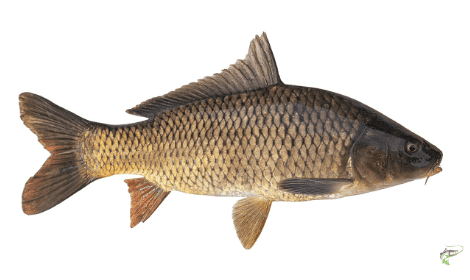
Background
Well, where do we start? The bottom-feeding common carp is sometimes referred to as the “European Carp” or “Cyprinus carpio”.
Considering this carp has the word “common” in its name, you would automatically assume that you will have more chance of catching this species than any other at commercial fisheries, but this is not the case.
Often fisheries will stock a larger quantity of “mirror carp” so hooking into a massive common is an exhilarating experience.
The common carp is native to Europe and Asia but has been introduced into near enough every part of the world and has been farmed for food dating back to as far as Roman times.
Nowadays in the UK, this is not the case as carp are primarily stocked for the satisfaction of our anglers.
In the Czech Republic, Poland and Slovakia carp are sometimes eaten as part of their Christmas dinner.
If you want to learn more about eating carp, read this post, which explores if carp are edible.
“Native” common carp are currently marked as “vulnerable” to extinction by the International Union for Conservation of Nature.
This is quite surprising considering the abundance of carp in many lakes and rivers across the world but the majority of these fish are classed as “domesticated” and have been bred for angling or introduced to control aquatic plants and pest organisms.
Common carp are now classified as an invasive species and are included in the list of the top 100 invasive species and are seen as pests in many areas due to their ability to out-compete native fish species.
The world record common carp currently stands at a massive 64lbs (as of March 2018) and was caught in Avenue syndicate in Shropshire.
Distinctive Features
So how do you know if you’ve caught a common carp? Well, it’s easy. Common carp are covered with regular scales ranging from grey to bronze in colour.
Common carp have four barbels and a large elongated dorsal fin which can be seen in the picture above.
“Domestic” carp grow a lot larger than native carp and are much larger with deeper bodies. The current common carp world record stands at 64lbs, but I can almost guarantee this number will continue to be broken over the years.
These carps have large mouths, perfect for gulping down large boilies.
Mirror Carp
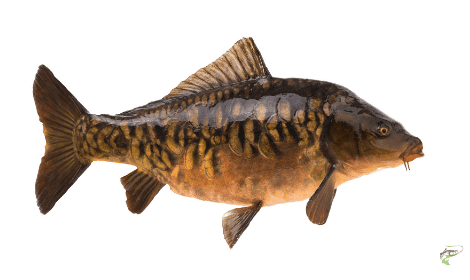
Background
Mirror carp are a subspecies of the common carp and were the first mutation of common carp.
Biologically mirror carp are almost identical to their predecessor, the common carp.
The lack of scales found on the mirror carp is commonly thought to be from the breeding of monks to make the fish easier to consume as fewer scales have to be removed before serving.
Mirror carp are thought to have been introduced into Britain in the 15th century as a food source.
Nowadays, mirror carp are mainly bred and introduced into commercial fisheries for us anglers.
Like the common carp, they fight extremely well and grow to unreal sizes in the right environments.
As well as breeding for fewer scales mirror carp were also bred to grow to greater sizes than commons which can be clearly shown by the most recent world record.
The reason for this is that commons take a lot of energy growing scales covering their full body whereas mirror put this energy to growing in overall size rapidly.
The world record mirror carp stands at an unbelievable 108lbs (November 2018) and was caught in Hungary at Euro Aqua fishery.
Distinctive Features
Mirror carp are visually different from common carp as they have irregular and patchy scales shown in the picture above.
All mirror carp’s scale patterns are different giving them a sense of character.
Mirror carp tend to have a rounder appearance than common carp.
Mirror carp also have large mouths just like the commons and have two barbells at each side of their mouths.
Grass Carp
Background
The grass carp or “Ctenopharyngodon idella” is another species of carp native to China.
The grass carp was introduced into many countries worldwide including Europe and the United States for aquatic weed control.
They were first introduced in the UK on the Lancaster canal as an experiment into weed control conducted by British Waterways and the University of Liverpool.
Grass carp reproduce in water temperatures over 20 degrees Celsius, so they cannot reproduce naturally in the UK.
This allows their population to be carefully controlled by the Environmental agency, unlike commons and mirrors.
It was initially thought that grass carp would take little interest in commercial fishing baits, but this thought was soon discarded as more and more and more grass carp were caught by us anglers.
Grass carp grow rapidly most likely due to them eating up to three times their body weight each day!
In the UK grass carp can be caught at selective fisheries including Badshot Lea, Mill lane, Little Moulsham Lake and of course the Lancaster Canal.
Little Moulsham Lake produced a grass carp of nearly 52lbs in August 2018.
Distinctive Features
Grass carp are quite dark and range from yellowish to brown.
Grass carp are longer and slimmer and have “torpedo-like” body shapes and lack barbels beside their mouths.
The anal fin is located closer to the tail.
Grass carp have sale patterns similar to commons.
As you can see from the picture grass carp’s dorsal fins are smaller and not as long as commons or mirrors which helps to easily identify them.
They have low flat heads, and their mouths are much smaller than mirrors and commons.
Leather Carp
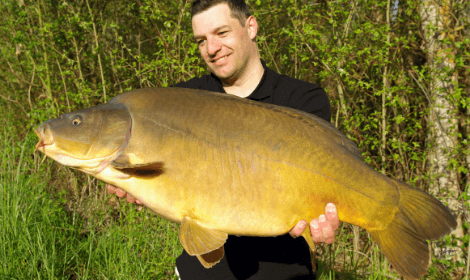
Background
The leather carp is another subspecies of the common carp and is thought to be a mirror carp with no scales, but this is not the case with the leather carp having some distinct genetic differences from mirrors.
Leather carp have fewer red blood cells than mirrors or commons which stunts their growth.
Due to this hooking into a giant leather is an achievement and they are known to put up an excellent fight.
It is difficult to find out much background information on the leather carp due to their rarity.
Distinctive Features
Leather carp have near enough no scales apart from an occasional row across the dorsal line and the base of the tale. A “perfect” leather carp has no scales at all.
Their skin looks almost like leather hence the name, and from this, they can be easily identified.
Leather carp’s colour can range from dark green to dark bronze.
The anal fin often has fewer rays than commons and mirrors and the dorsal fin is often imperfect
Crucian Carp
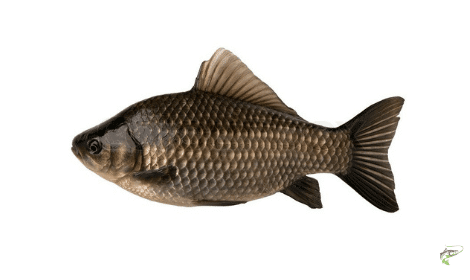
Background
The Cruician Carp is yet another member of the carp family and is the smallest.
It shows up widely across Europe and can even be found as far north as the Arctic Circle in Scandinavian countries.
They can survive in conditions that many other fishes cannot deal with, including the smallest of weedy, muddy pools to extremely cold waters.
Catching a large crucian carp can be challenging as they are the most delicate feeders of the carp family.
Even a 2lb crucian is considered a great catch which puts into perspective how small these fish are compared to all other carp species discussed in this post.
Instead of gulping in baits crucian carp tend to nudge the bait and suck very gently to check for our hooks.
This can become extremely frustrating to carp anglers targeting these fish.
But still, if you intend to target these fish they can usually be found near drop offs into deep water.
Distinctive Features
As stated before crucian carp are the smallest of the carp family and rarely grow over 6 lbs.
Crucian carp vary in usually golden or bronze looking and darken with age, and they have yellow or orangeish fins.
Crucian carp are quite tall fish as they mature.
Crucian carp have no barbells.
Koi Carp
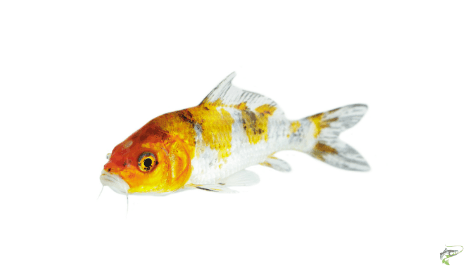
Background
The Koi carp was initially bred in Japan in the 1820s in the town of Ojiya for its bright colours.
The word Koi, therefore, comes from Japan and simply translates to “carp”. Apart from select areas in Japan, the Koi carp was never seen by the outside world until 1914 after they were displayed at a public exhibition in Tokyo.
After this, the Koi carp took off, and many new variations were bred. Keeping Koi carp as a hobby spread quickly across the world and they were mostly kept as ornamental fish.
There are now thought to be more than 22 varieties of Koi with new variations being actively developed. Each variety has certain distinct colours, patterns and certain scaling.
Koi have been released into near enough every continent except Antarctica, but they quickly revert to the colouration of common carp in only a few generations.
Keeping Koi in a pond puts them at a severe disadvantage against predators.
Due to their highly visible colouration predators including herons, badgers, otters, foxes and even cats can be capable of emptying a full pond of your hobby fish if measures aren’t taken to avoid this.
Well-designed ponds have areas too deep for Herrons to stand, overhangs so mammals can’t reach in and trees above the ponds so any birds flying past can’t spot their next meal in the water.
Many carp lakes in the UK stock a few Koi and you can even find a dedicated Koi fishing pond at Anglers Paradise in Devon.
Distinctive Features
I believe Koi carp are the easiest to identify due to their obscure and bright colour patterns. Koi carp come in many colours, including white, black, red, orange, yellow, blue, and cream, in all different patterns, but the colours are near limitless.
Koi carp are extremely similar to goldfish in shape, and except for the fact they grow much larger and have two barbels which goldfish do not.
F1 Carp
Background
The F1 carp is a relatively new species to the UK but is now commonly one of the most stocked.
The F1 carp is a hybrid between common and crucian carp so is smaller than commons or mirrors.
This cross-breeding occurs naturally in the wild, but these fish are widely bred for stocking commercial fishing waters.
F1 carp feed all year round so grow rapidly. This is one of the reasons why this new species of carp is in such high demand.
Although F1 grow quickly, they don’t grow to the massive sizes of other carp species.
They usually grow to around under 5lbs with some exceptions.
The world record F1 carp currently stands at 7lbs and 14ozs and was caught in 2016 caught at Manor Farm leisure.
Distinctive Features
F1 carp can be hard to identify as they look a lot like a smaller common.
A way to determine if you have caught an F1 carp is to look at their barbells. F1 carp only have two smaller barbells compared to commons barbells.
Ghost Carp
Background
Although fairly uncommon, the ghost carp is another member of the carp family that can be found swimming in some UK fisheries.
These fish are sometimes referred to as Ghost Koi and result from breeding between common carp and two koi variations.
The Purachina Koi produces white ghost carp and the Yambuki produces yellow ghost carp.
This hybrid fish tend to grow faster than pure-bred koi and can compete for food with all variants of the carp family.
These fish typically live up to 30-70 years in the UK with longevity similar to pure-bred koi.
Distinctive Features
Ghost carp are easy to distinguish due to their abnormal colouration. Their striking white or yellow colours make them easy to spot.
They commonly have darker scales along their back and dark markings on their heads.
They are similar to common carp with full-scale patterns and elongated dorsal fins.
Other Carp Species
There are many carp species out there, not just in Europe, but different species proliferate around the globe, whether they are native to those areas or in many cases such as North America, invasive species.
Many of these species have become popular to fish for or in some cases bowfished. Let’s take an in-depth look at some of the most popular species.
Bighead Carp
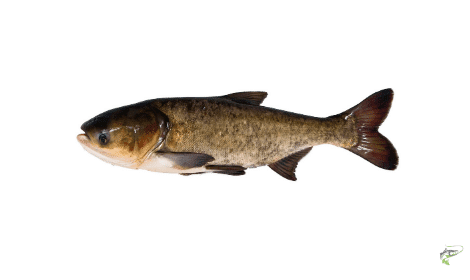
Bighead carp are one of the several Asian carp species out there. They have been introduced worldwide and can be found in many North America, Europe, India, and South America.
Bighead Carp are very popular in terms of commercial aquaculture, being the fifth highest farmed fish in the world, coming in at 7.5% of all commercially farmed fish.
Bighead carp mature in 2-3 year years after hatching and are commonly found in weight ranges of around 40 pounds, but in rare instances can reach 80 pounds in length.
Due to bighead carp being filter feeders, it’s incredibly difficult to catch on rod and reel due to them simply not eating large prey.
In North America, this means that anglers snag them if it’s legal, or in most cases shoot them with a bow and special arrows designed for bowfishing. Bowfishing has become incredibly popular over the last decade and is also beneficial in keeping populations of the invasive species in check.
As mentioned earlier, bighead carp are filter feeders. They are also voracious feeders, consuming large amounts of zooplankton, small invertebrates, and other detritus outcompeted native species in the introduced bodies of water they inhabit. Bighead carp also lack a true stomach, and this forces them to feed continuously.
Like other carp species, bighead carp are incredibly hardy and can adapt to a wide range of habitats, which is also the cause for their widespread invasive distribution.
Silver Carp
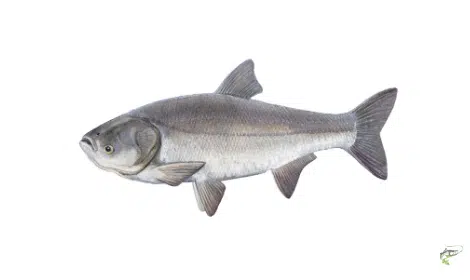
Silver carp are very similar to bighead carp in many ways and are native to the same areas as the bighead carp.
There are some differences between the two though; one that stands out the most is their tendency to leap out of the water and go airborne when disturbed.
They can reach the same size as the bighead carp, with a maximum weight of around 100 pounds and a maximum length of 55 inches, though fish of these sizes are incredibly rare.
Silver carp are a massive issue for the native ecology of waters they inhabit that are not native silver carp waters.
As of now they have spread to 88 different countries. These fish have been introduced to many waters due to escaping from commercial fish farms during accidents or flooding and in some cases were introduced on purpose for reasons such as water quality control or as an “enhancement” to wild fisheries.
In terms of sport fishing, silver carp are like bighead carp. They are filter feeders and thus are incredibly hard to target with a rod and reel.
In the United States, in particular the Illinois river basin, bowfishing has become incredibly popular for asian carp.
Boats cruise slowly down river with the engine noise and vibrations causing thousands of asian carp to leap high out of the water. When the carp leap bow fishermen waiting with bows drawn shoot at these aerial targets.
Some local companies have taken advantage of the bowfishing frenzy in the United States near asian carp waters, with some turning the carp into food for farm animals such as chickens, with some also using netting operations to maintain their supply.
Black Carp
Black carp, or the “Black Chinese Roach” are very similar to the grass carp in appearance, but as the names suggests, they are much darker in appearance with some having most of their body, especially along the back being almost black in appearance.
Black carp are native to east Asia, from ranges in China and Vietnam, but have like most carp species been introduced in some form to the United States as well.
Black carp are used in aquaculture as pest control, eating snails that carry parasites which in turn use the other commercially raised fish as a host.
In some instances, Black carp were intentionally introduced to control and hopefully eliminate invasive snails and mussels.
No state in the United States allows for the intentional release of black carp into any waterway, but 60 confirmed black carp have been captured in the Mississippi river, and 2 fingerlings were also captured in a body of water in Missouri.
Black Carp getting into non-native waterways can wreak havoc on native snail and mussel species which could cause the extinction of those species that are currently already at risk.
Black carp fishing is popular in its native areas and are a prized delicacy in areas of Asia. It is also incredibly popular in China for traditional medicinal beliefs.
Rohu
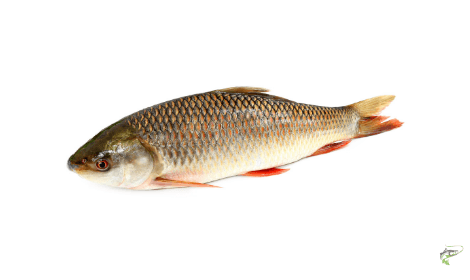
Rohu are a carp species that proliferate in the countries of India, Myanmar, Bangladesh, Pakistan, and Nepal. They also have been introduced into some peninsular rivers of India and in waterways in Sri Lanka.
The species is an omnivore with very specific food preferences that occur at different stages of its life. They prefer zooplankton and phytoplankton in the early stages of their lives, and as they mature switch to a combination of those same prey mixed with submerged vegetation.
Rohu become sexually mature anywhere from 2 to 5 years in age, and their spawning coincides with the monsoon season.
The Rohu is particularly popular in commercial aquaculture in the same regions where it is found but will not naturally reproduce in lake systems or tanks, thus artificial propagation is required.
There you have it!
I’m sure you can now see that differentiating between types of carp shouldn’t be difficult.
Each have their own distinctive features and after having a good read at this post you should known all about it. One thing is for sure though is that all carp species can be extremely exhilarating to catch.
Especially the huge fish touching the 30lb mark which can be found at many venues across the UK.
If you have anything to add or any questions feel free to leave a comment below and I’ll get back to you.

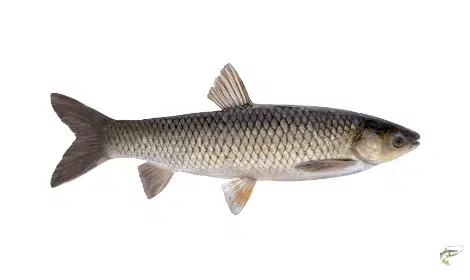

Great information ?
Glad you liked it, cheers!
So many different carp in the world.
Yep you are right, there is far more variations of carp across the world but these are the most likely to be caught in the UK.
Hi, today i have caught what i believe to be a carp, everything tells me its a carp. But i dont know what type. Ive caught plenty of all species but this one has me stumped. It was almost purple in colour with jet balck eyes and reddish cheeks, also was slimy unlike any other carp i have ever caught. Can anyone help me?
Hi Chris,
Sound like a strange one to me and definitely not anything I’ve personally come across so can’t really help you here unfortunately. I did a quick google search and found a similar fish to the one you described here in this post;
https://sites.google.com/site/coolingangling/summer-holiday-fishing?tmpl=%2Fsystem%2Fapp%2Ftemplates%2Fprint%2F&showPrintDialog=1
Is this similar? Definitely looks like a small common to me but that really doesn’t explain that purple tinge or black eyes. I’m rather clueless here as well. Hopefully someone else that reads this post will be able to enlighten us both, cheers for looking for answers here though and I hope you return!
this was very helpful thank you
Not a problem, glad you found it useful. Cheers.
Brilliant summary, thanks Drew!
Thanks for your information!
Not a problem, glad you found it useful.